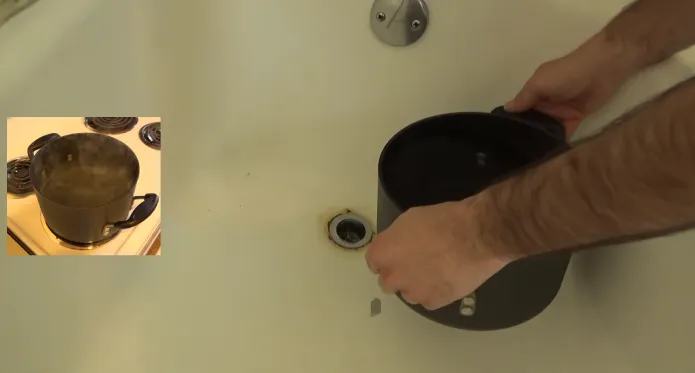Last Updated on July 23, 2023
A clogged drain can be an annoying problem to deal with, but don’t worry. Boiling water may be a simple and effective way of removing blockages in your pipes. Make sure you take safety precautions when handling extremely hot liquids before taking on this task.
Learn how to effortlessly clear a clogged drain with boiling water while being aware of potential risks. We have compiled some convenient guidelines to ensure that future drainage systems run efficiently. Read on to find out if boiling water is the right choice.
How to Use Boiling Water to Clear a Drain: 7 Steps
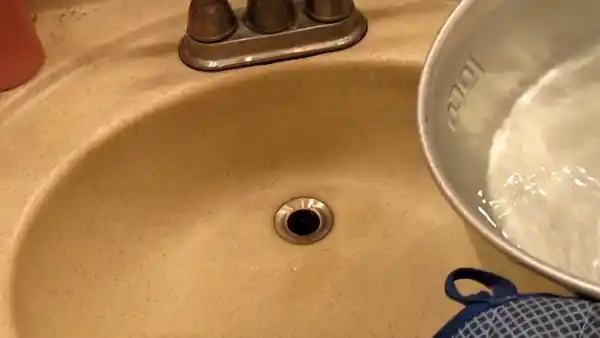
Here are some steps you can follow to utilize boiling water for clearing a drain safely and effectively:
Step 01. Gather Your Supplies
You will need a large pot or kettle, a stove or hot plate, and a protective item such as oven mitts or gloves. You may also want to have a plunger or other tool on hand in case the boiling water does not completely clear the clog.
Step 02. Fill the Pot or Kettle with Water
Pour water into the pot or kettle, making sure not to fill it more than about half full to leave room for the water to boil.
Step 03. Heat the Water
Place the pot or kettle on the stove or hot plate and heat the water until it reaches a rolling boil. Be sure to use a low or medium heat setting to avoid overheating the water and potentially causing it to boil over.
Step 04. Pour the Water into the Drain
Once the water has reached a rolling boil, carefully pour it into the drain. Be sure to use caution and protect your hands with oven mitts or gloves to avoid scalding.

Step 05. Allow the Water to Sit for a Few Minutes
After pouring the boiling water into the drain, set aside for a couple of minutes to allow the heat to soften any grease or grime that may be clogging the drain.
Step 06. Flush the Drain with Cold Water
After a few minutes, run cold water down your drain to help cool the pipes and to push any remaining debris or clogs through the pipes.
Step 07. Check to See if the Clog Has Been Cleared
After flushing the drain with cold water, observe if the clog is vacated. If the drain is still clogged, you may need to try a different method or call a professional plumber for assistance.
Following these steps, you can use boiling water to clear a drain safely and effectively. Be cautious to protect your hands to avoid scalding, and be prepared to try a different method if the boiling water does not fully clear the clog.
Boiling Water Can Cause Drain Pipes to Deform or Melt
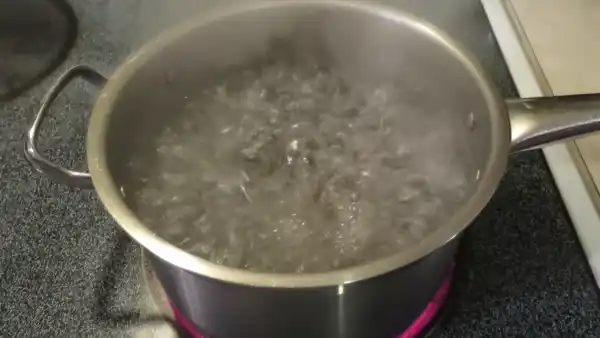
The heat from boiling water can cause the material of your drain pipe to become softer and more pliable as you pour boiling water down the drain pipe, and the temperature of the pipe increases.
The boiling hot water molecules within your drain pipe then begin to move faster, and the bonds between the drain pipe material become looser. This can cause your drain pipe to turn softer and more flexible.
In the case of plastic pipes made of malleable materials, such as PVC, the hot temperature caused by boiling water can provoke the plastic to become soft enough to deform or even melt. This is especially true if the water is in contact with the pipes for an extended time.
It is generally not recommended that you use boiling water to clear your clogged drain if the pipes are made of PVC or any other type of plastic that may be sensitive to heat, as it can potentially cause damage to the pipes.
Some Blockages May Still Remain After Using Boiling Water
When boiling water is used to try to clear a clogged drain, some stubborn blockages may still remain. Some possible reasons include the following:

- The clog is located too far down the pipes for the boiling water to reach: If the clog is located deep in the pipes, the heat and pressure of the boiling water might not be sufficient to push the clog through the pipes and out of the drain.
In these cases, the boiling water may be able to soften the drain clog or loosen it up slightly, but it may not be competent to remove it fully.
- The clog is too large or hard to be dislodged by the boiling water: If the drain pipes clog is clogged up with large or hard objects, such as tree roots or broken glass, the boiling hot water may not be able to remove it effectively.
In these cases, the clog in your drain pipe may be too dense or too firmly stuck in the drain pipes for the boiling hot water to dislodge it effectively.
- The pipes are damaged or corroded: If the pipes themselves are previously damaged or corroded, the hot boiling water may not be capable of effectively clearing the drain clog, as the boiling water won’t be able to flow through the pipes properly.
Various factors, such as age, deterioration, or exposure to harsh chemicals, can cause this.
- The clog is caused by a problem with the main sewer line: If the drain clog is brought on by an obstruction with the primary sewer line, boiling water alone may not be sufficient to clear it.
In these cases, it may be necessary to call a professional plumber to diagnose and fix the drain clogging problem. The main sewer line is the large drain pipe that carries wastewater from the home to the city sewer system or septic tank.
If there is a blockage or other issue with this pipe, it can cause problems with the entire plumbing system.
Risk of Scalding if Handled Improperly
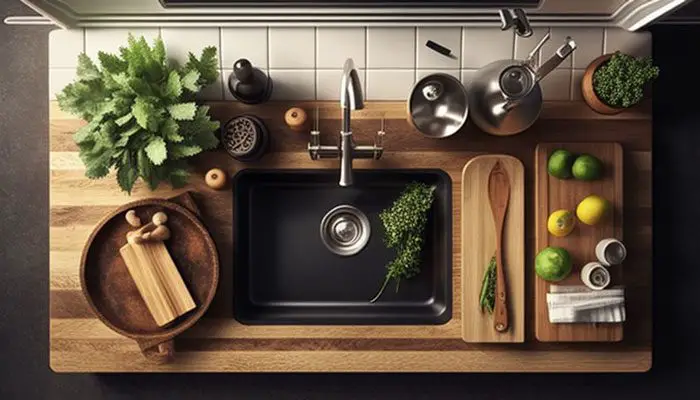
Why May It Scald?
There is a risk of scalding if you mishandle the boiling water, such as poured into a drain with too high of a temperature setting.
The heat of the boiling water can cause the drain pipes to become hot when the boiling water is poured into a drain.
Excessively high temperatures of the drain pipes can burn people if they accidentally come into contact with them, which can cause scalding.
What is Scald?
Scalding is a type of burn that is caused by contact with hot liquid or steam. It can be excruciating and cause redness, blistering, and skin damage. In severe cases, scalding can cause scarring and may require medical attention.
It is essential to be cautious when using boiling water to clear a blocked drain pipe, as the risk of scalding can be significant if the water is not appropriately handled.
To minimize the risk of scalding, it is best to use water not quite at a rolling boil and to exercise caution when pouring the water into the drain.
It is also a good idea to wear protective clothing, such as gloves or oven mitts, to protect your hands from the heat of the water.
Alternatives to Using Boiling Water Clear a Drain
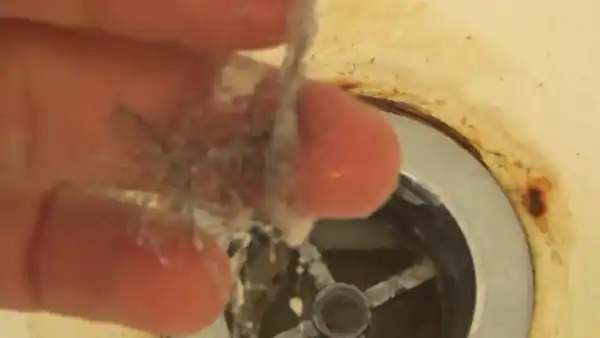
When boiling water is unable to clear a clogged drain, there are several creative alternatives that can be utilized. The options for unblocking a drain include using a plunger, an enzyme-based cleaner, or a vinegar and baking soda mixture. For more intense blockages, the pipes can be snaked out by hand or mechanically.
Plungers and Pipe Snakes
1. How do pipe snakes and plungers work to clear clogs?
There are two common methods to clear a clogged drain: plungers and pipe snakes. Plungers use suction to dislodge blockages, while pipe snakes can be pushed or pulled through pipes to break up buildups. Pipe snakes come in various sizes depending on the size of the obstruction.
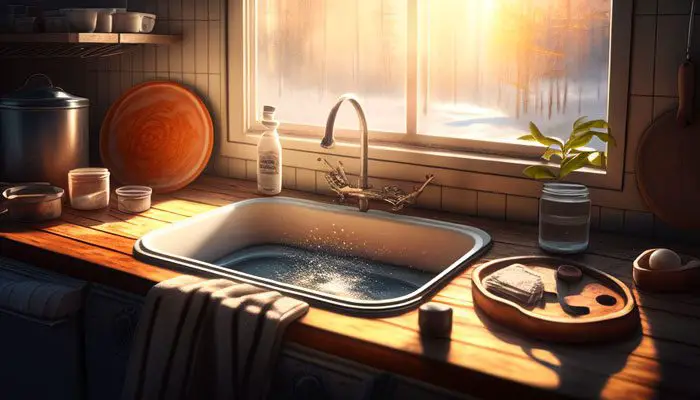
2. What are their strengths and limitations?
The advantage of using plungers and pipe snakes is that they don’t involve harsh chemicals that could damage your plumbing system or corrode fixtures over time, as chemical cleaners do.
Furthermore, these tools are inexpensive compared to professional plumbing services, making them ideal for DIY homeowners who want to avoid costly fees from plumbers.
However, their effectiveness depends on how deep the clog is in your pipes. If it’s too far down or stubbornly lodged, you may need more specialized tools or even a professional plumbing service to get it cleared out properly.
In addition, plungers require some practice before you can expect consistent results; if you don’t push hard enough or don’t create enough suction when using one, it won’t be effective at breaking up tough clogs.
What is the Fastest Way to Clear a Clogged Drain?
The fastest way to unclog a clogged drain is by using a plunger. This is because plungers create suction which dislodges and clears away any obstruction in the pipe without causing any damage.
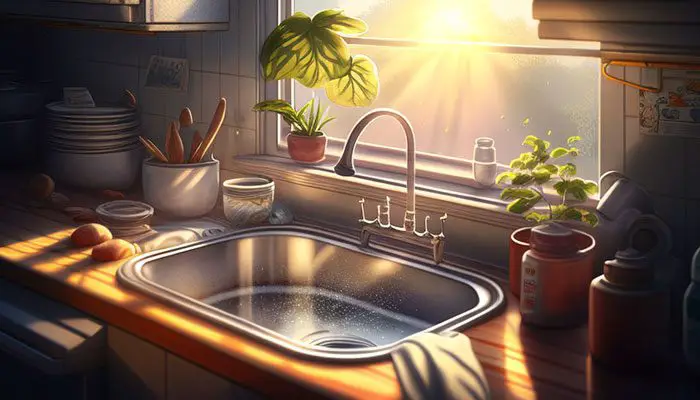
To use a plunger effectively, fill the sink with enough water to cover the plunger cup. Then place the plunger over the drain and press it firmly before pulling up quickly to create suction. It may take several tries before you get results, but it’s usually fast and effective when done correctly.
Can Vinegar and Boiling Water Unclog the Drain?
Yes. Vinegar and boiling water work together to unclog stubborn drains without causing damage. Start by filling up a pot with 4 quarts of boiling water while simultaneously pouring 2 cups of white distilled vinegar into your sink or tub.
Let this sit for 30 minutes before flushing with cold running tap water afterward. Repeat once more if needed.
This method works great because vinegar breaks gunk buildup while boiling water helps melt away hardened garbage like soap scum or grease, which makes removing blockages easier overall.
Final Thoughts
Using boiling water to unclog your drains can be an effective solution for removing stubborn blockages. It is essential to exercise caution when using this technique, however, as it has the potential to cause damage if handled improperly.
Ensure that you have all the necessary supplies on hand before beginning the process, and take proper safety precautions once you do start working on your clogged drain.
If you find that boiling water does not do the trick for your particular problem, there are other alternatives, such as chemical products or manual tools, that could help get the job done.
Ultimately, with proper knowledge and diligence, it is possible to clear out any blocked drain yourself successfully.

